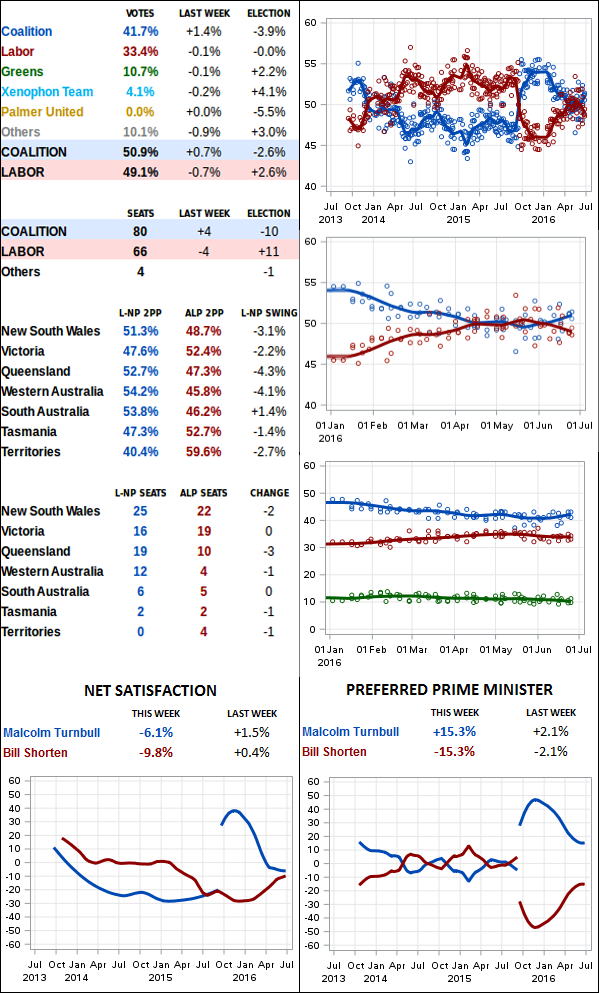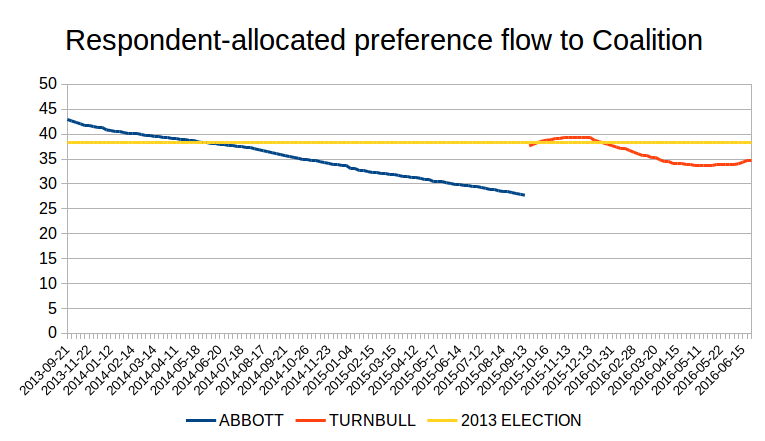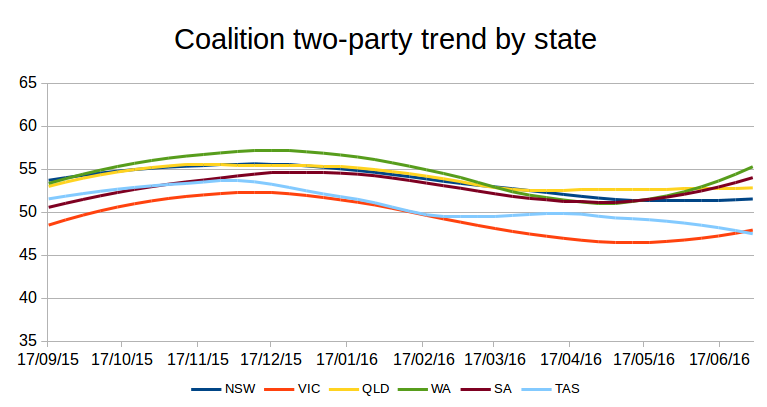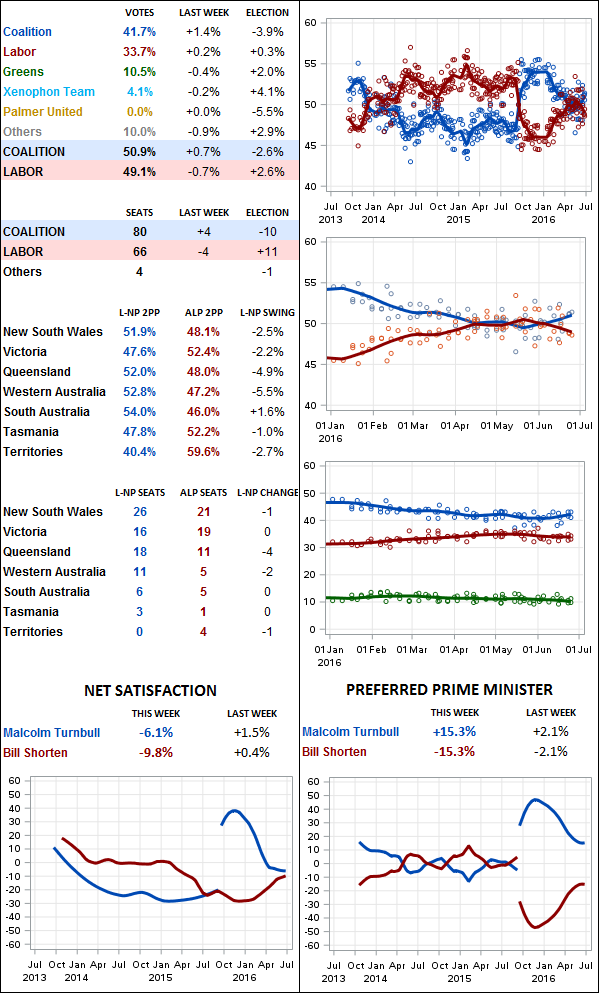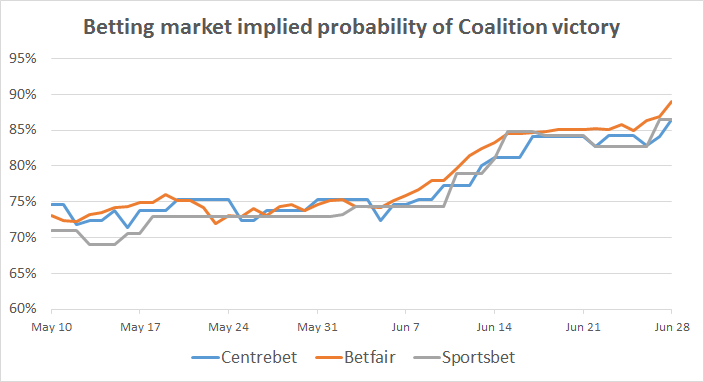At the end of the evening, a surprising election result hangs in the balance, with a remarkably long list of seats still up for grabs. What looked a slightly disappointing result for the Coalition early in the evening kept getting worse as the night progressed, with a number of seats that looked okay for them early on moving Labor’s way late in the night. Anything is possible, but I would now rate a hung parliament of some kind the most likely outcome, and it’s by no means impossible that it won’t be the Coalition forming the minority government.
At the 2013 election, the Coalition won 90 seats, Labor won 55, and others won five: one each for the Greens, Palmer United and Katter’s Australian Party, and two independents. Redistributions then took place in New South Wales, which lost a seat, and Western Australia, which gained one. In New South Wales, the Labor seat of Charlton in the Hunter region was abolished, but in the resulting reorganisation, Charlton’s neighbour Paterson went from Liberal to notional to Labor, as did Dobell on the Central Coast and Barton in southern Sydney. The three notionally Labor seats are now actual Labor seats, bringing the Coalition down to 87. In Western Australia, the new seat of Burt had a notional Liberal margin of 6.0%, but Labor blew the hinges off that with a 14% swing. Now let’s take a Coalition-centric look at what happened state by state.
In New South Wales, the Coalition has lost Eden-Monaro, Macarthur, Macquarie and Lindsay, and are going down to the wire in Gilmore. That brings them down to 83, with one on the endangered list.
In Victoria, there is little or nothing in it in Labor-held Chisholm and Liberal-held Dunkley. So that brings the endangered list up to two, but also brings one on to what I will call the opportunity list (which won’t be getting any longer).
In Queensland, Labor has won Longman and, following a late-evening turnaround, Flynn. Capricornia and Herbert look better for Labor than the Coalition, but I’ll nonetheless assign them to the endangered list, along with the genuinely lineball Forde, and Dickson where Peter Dutton will probably but not definitely make it over the line. Not surprisingly, Fairfax, which Clive Palmer won in 2013, goes back to the LNP. That brings them to 82, and intensifies the headache in trying to assess the situation by making it six on the endangered list.
In Western Australia, besides the previously noted Burt, Cowan could go either way. Now we have seven on the endangered list.
In South Australia, Mayo has gone to the Nick Xenophon Team as expected, bringing the best case scenario for the Coalition down to 81. Furthermore, the endangered list gets still longer with Hindmarsh lineball; Grey looking to me like a show for the NXT, with their candidate second and the Liberal member on an unconvincing primary vote of 41.6%; Boothby a less likely but still possible gain for NXT, if their candidate overtakes Labor by doing 4.6% better than him when the 13.4% Greens-plus-others vote is split three ways on preferences. Now our endangered list blows out to ten.
Tasmania at least is neat and tidy, with a surprisingly poor result for the Liberals costing them all of the three seats they gained in 2013, with Bass going on a second consecutive double-digit swing. And Labor won the Darwin seat of Solomon in a result that bodes ill for the Country Liberal Party government at their election in late August.
That brings the Coalition down to 77, which they can hope to push up to 78 if they win Chisholm. But then there’s that intimidatingly long endangered list of ten, and while they can hope to rely on the traditional tendency of postal votes to favour them, they would need to be very lucky to make it to a majority.
As for the cross bench, Andrew Wilkie, Cathy McGowan and Bob Katter were easily re-elected; Adam Bandt retains Melbourne for the Greens, and the NXT wins Mayo; and both NXT and the Greens could gain an extra two seats each with a bit of luck (quite a lot of luck actually, in the Greens’ case).
Ultimately, the spread of possibilities for the Coalition ranges from 69 to 78, while Labor’s is only slightly weaker at 63 to 75. If Labor falls below 65, it will do so by losing seats to the Greens, who would assuredly favour them to form government.
Now for the Senate.
In New South Wales, the Coalition wins five, Labor four, the Greens one and One Nation one, with the last seat up in the air. Based on my somewhat speculative preference model, Labor gets enough preferences for their fifth candidate to compete with the Liberal Democrats for that seat, but that may be overrating the Liberal Democrats preference flow based on their strong performance from top position on the ballot paper last time. The other possibility is that it goes to the Christian Democratic Party.
In Victoria, the Coalition and Labor get to four; the Greens should make it to two; and Derryn Hinch has won a seat. The last seat is anyone’s guess, but I’m inclined to think it will be a fifth seat for the Coalition.
In Queensland, there should be five Coalition, four Labor, one Greens and Pauline Hanson, and another tough call for the last spot. The Liberal Democrats are a surprisingly good show, but I wouldn’t rule out Family First.
In South Australia, four Liberal, four Labor, three NXT, one Greens. Surprisingly, Bob Day of Family First doesn’t look like he’ll make it.
Western Australia I expect will be five Liberal, one Nationals, four Labor, two Greens. In Tasmania, five Labor, four Liberal, two Greens and Jacqui Lambie.
